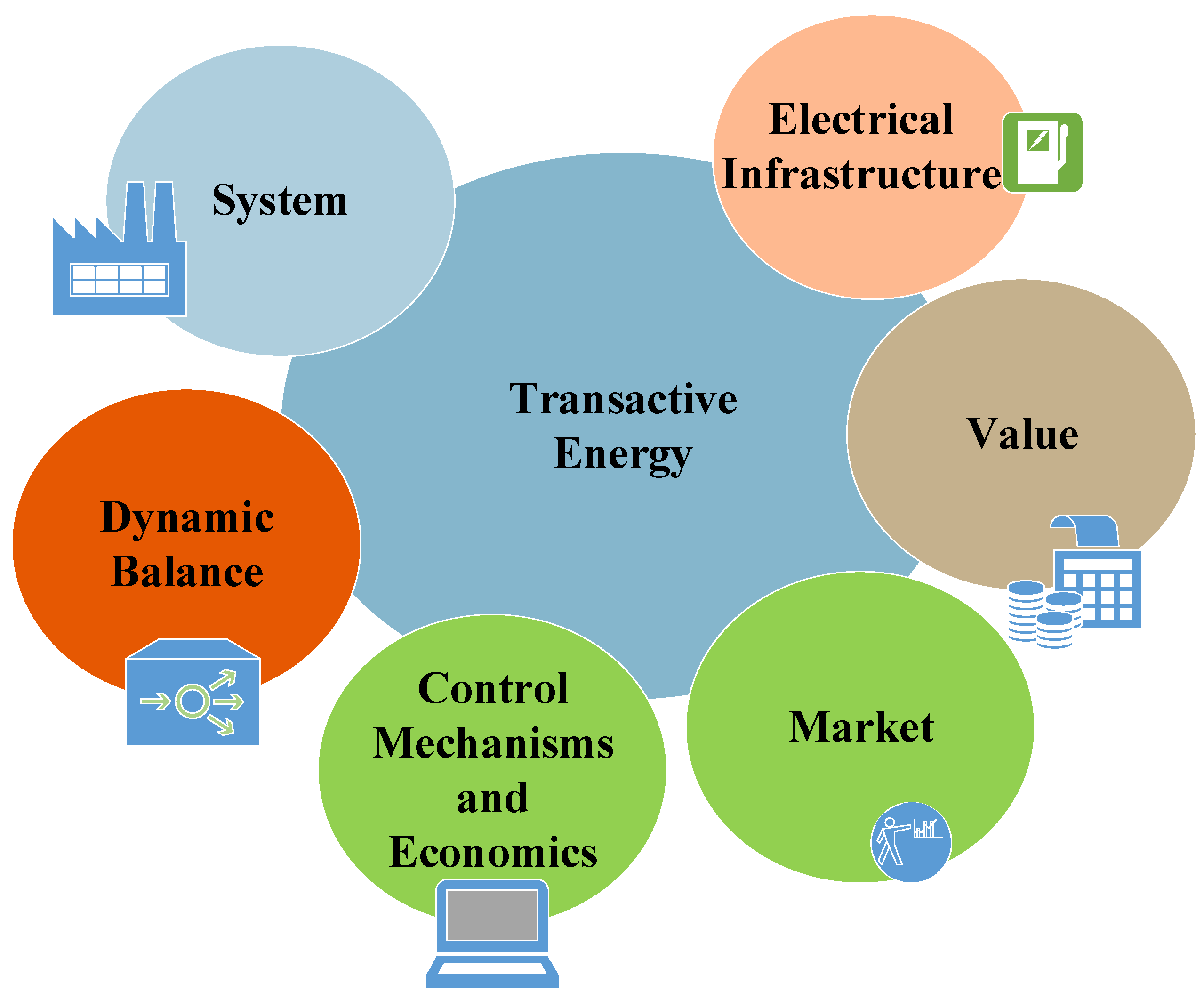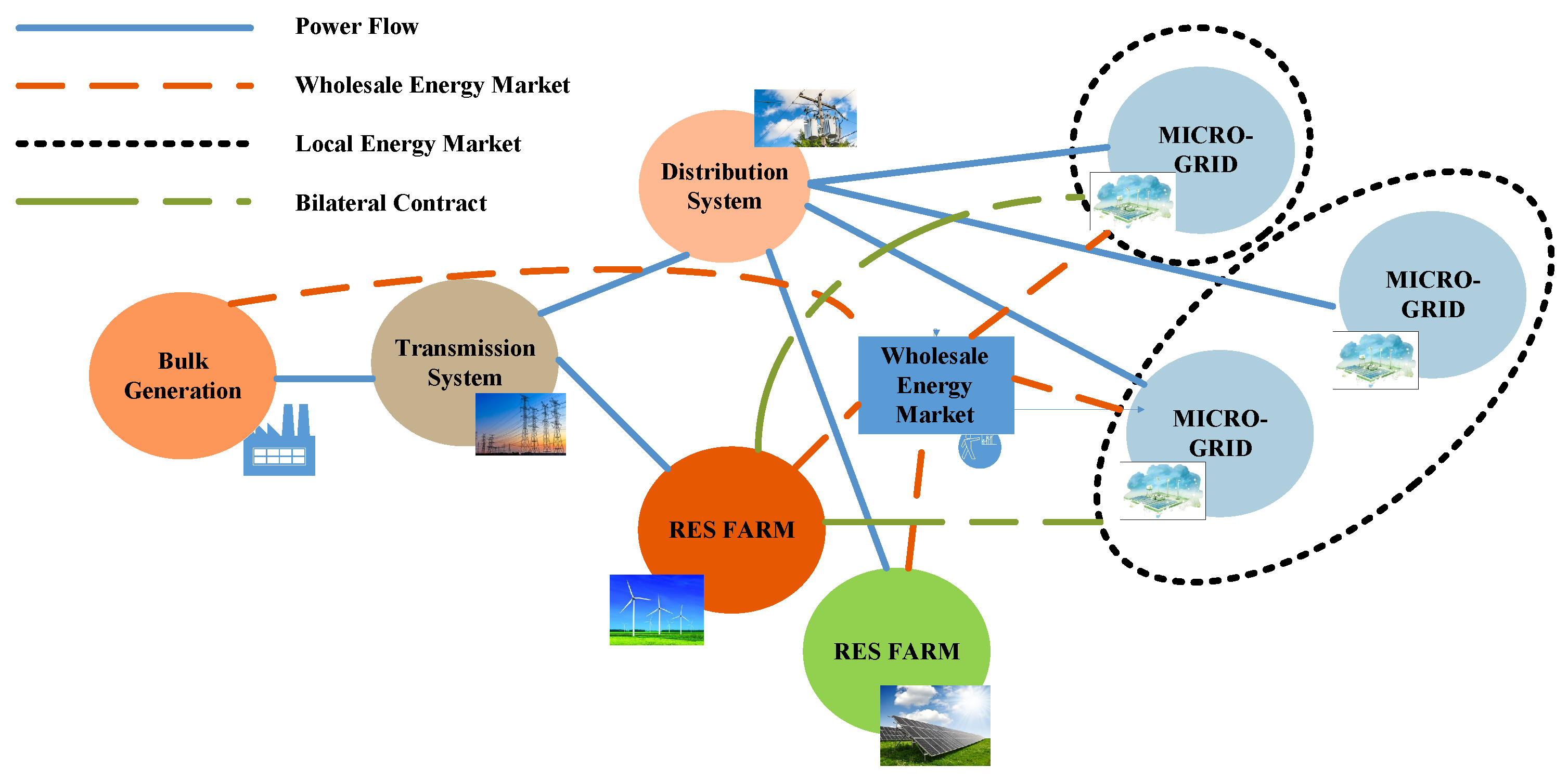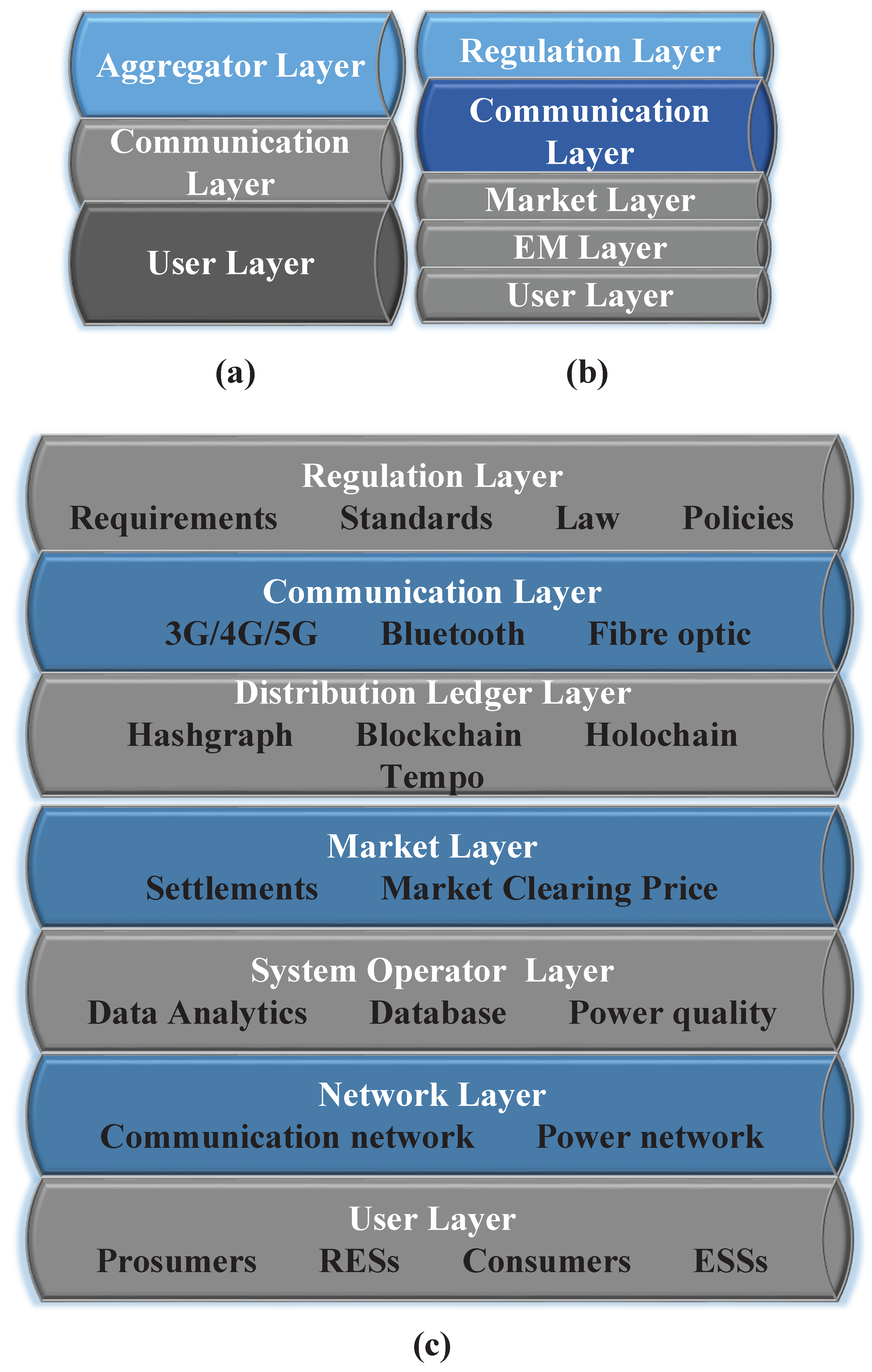Your browser does not fully support modern features. Please upgrade for a smoother experience.

Submitted Successfully!
Thank you for your contribution! You can also upload a video entry or images related to this topic.
For video creation, please contact our Academic Video Service.
| Version | Summary | Created by | Modification | Content Size | Created at | Operation |
|---|---|---|---|---|---|---|
| 1 | Neeraj Gupta | -- | 1640 | 2022-11-15 10:33:16 | | | |
| 2 | Sirius Huang | Meta information modification | 1640 | 2022-11-16 02:56:58 | | |
Video Upload Options
We provide professional Academic Video Service to translate complex research into visually appealing presentations. Would you like to try it?
Cite
If you have any further questions, please contact Encyclopedia Editorial Office.
Gupta, N.; Prusty, B.R.; Alrumayh, O.; Almutairi, A.; Alharbi, T. Transactive Energy. Encyclopedia. Available online: https://encyclopedia.pub/entry/34707 (accessed on 15 January 2026).
Gupta N, Prusty BR, Alrumayh O, Almutairi A, Alharbi T. Transactive Energy. Encyclopedia. Available at: https://encyclopedia.pub/entry/34707. Accessed January 15, 2026.
Gupta, Neeraj, B Rajanarayan Prusty, Omar Alrumayh, Abdulaziz Almutairi, Talal Alharbi. "Transactive Energy" Encyclopedia, https://encyclopedia.pub/entry/34707 (accessed January 15, 2026).
Gupta, N., Prusty, B.R., Alrumayh, O., Almutairi, A., & Alharbi, T. (2022, November 15). Transactive Energy. In Encyclopedia. https://encyclopedia.pub/entry/34707
Gupta, Neeraj, et al. "Transactive Energy." Encyclopedia. Web. 15 November, 2022.
Copy Citation
Transactive energy is a highly effective technique for peers to exchange and trade energy resources. Several interconnected blocks, such as generation businesses, prosumers, the energy market, energy service providers, transmission and distribution networks, and so on, make up a transactive energy framework.
blockchain
energy markets
network management
power system flexibility
transactive energy
1. Introduction
Every day, the number of new renewable energy power producers added to the world’s collective electrical grid continues to grow gradually. The number of assets needed to maintain the balance between supply and demand on that collective grid also is increasing. They increasingly rely on an intelligent and interactive networked system based on economics and market principles, where transactions are utilized to regulate the grid and maintain reliability and efficiency rather than on a standalone system [1]. It is a collaborative effort between companies, utilities, transmission operators, balancing authorities, government agencies, and standards organizations to define clearly the appropriate use of transaction energy (TE) systems and promote their implementations. Back in the day, most utilities were responsible for managing a limited number of power plants (e.g., 10–20) which required the same number of control points instead of massive points of control on the demand side now. The number of control points on the supply side of any given utility is expanding exponentially right now. TE is simply the system’s name that assists in managing a multitude of points of control in a system that can generate electricity. With the existence of a TE system, a network can facilitate communication between all points of supply and demand; thereby, this will ensure creating an environment of interoperability in which every point can exchange energy information and, in essence, discuss the value of energy at any time [2].
2. Transactive Energy Concept and Defintions
The TE modifies the traditional hierarchical grid structure and encourages a network environment for decentralized energy nodes. With TE, all energy producers and consumers can communicate with each other. TE provides increased consumer satisfaction, reduced energy cost, efficient use of energy and reliability compared to traditional energy systems as systems can share data and communicate with preservation of service and operational constraints. Various definitions of TE have been proposed by different individuals and organizations as follows:
“An internet-enabled free market, where customer devices and grid systems can barter over the proper way to solve their mutual problems, and settle on the proper price for their services, in close to real time.”[3]
“Techniques for managing the generation, consumption, or flow of electric power within an electric power system through the use of economic or market-based constructs while considering grid reliability constraints.”[2]
“A software-defined grid managed via market-based incentives to ensure grid reliability and resiliency. This is done with software applications that use economic signals and operational information to coordinate and manage devices’ production and/or consumption of electricity in the grid. TE describes the convergence of technologies, policies, and financial drivers in an active prosumer market where prosumers are buildings, electric vehicles, microgrids, VPPs or other assets.”[4][5]
“A system of economic and control mechanisms that allows the dynamic balance of supply and demand across the entire electrical infrastructure using value as a key operational parameter.”[1]
The most decent definition as stated by Gridwise Architecture Council [6][7]. TE is ‘‘techniques for managing the generation, consumption, flow of electricity within the power system that allow the dynamic balance between demand and supply keeping in view the constraints of the entire network".
In view of these definitions, it seems that the TS system enables multiple buyers and sellers in which energy will be effectively distributed from sellers to the buyers through a decentralized system, i.e., market, etc. Figure 1 shows the conceptual diagram of TE with different players involved. TE can be defined as software-defined grid driven by market incentives to provide stability and resilience and for controlling the generation, consumption, and flow of electricity in the power system in order to balance demand and supply. It comprises of several levels of market, system, control mechanism, etc., which maintain a dynamic equilibrium between load and generation using economic or market-based designs to increase electric power system reliability. It uses operational data to coordinate and manage device production and grid utilization.
It consists of a layer-type structure (i.e., independent system operators (ISOs), distribution system operators (DSOs)) or even a single customer can act as one layer), and there is an exchange of only boundary information as communication with others, i.e., each layer has its optimization objectives. However, in some cases, local management and distributed techniques are required to alleviate the issue of stability and reliability, which arises due to the obstruction of information exchange by the decentralized system [2][8]. This issue can be taken care of by distributed ledger technologies such as blockchain by removing the central control management [9][10] and facilitating distributed transactions. The distributed nature of renewable energy sources (RES) at the load end is also the reason for a decentralized framework for future TE markets [11][12].

Figure 1. Transactive Energy Concept [13].
3. Key Drivers of Transactive Energy
With the growing penetration level of renewable energy systems (RES) in conventional power systems, some new concepts and innovations are introduced, which includes decentralization, marketing, modernization, and digital transformation [14]. This also includes consumers’ participation and the activation of their role in managing electricity services as both consumers and producers of electricity. In general, the main drivers identified are:
- Grid operations, advanced control and communication technologies, microgrids, etc.
- Customer engagement as a producer.
- Grid modernization activities that includes incentives of the state.
At the distribution level, the move toward the TES involves restructuring the utility into different entities, e.g., generation, transmission and distribution, and deregulation, which is possible through grid modernization. From the technology perceptive, TES involves innovations in conventional power systems and the cross-discipline integration of communication networks, control data science, and artificial intelligence. For example, the cross-technology integration of sensor layers includes an IEEE 802.15-based personal area network, low-power WAN, and power line communication. Cross-domain data integration includes various sources such as smart homes, smart living, etc. Cross-hardware integration includes sensors, actuators, gateways, and network equipment from various manufacturers. Cross-data integration includes different areas such as advanced metering infrastructure (AMI), meter data management systems, distribution management systems, etc.
From the society perceptive, innovation in TES involves the real-time management of energy supply and demand, vehicle to the grid, building to building, and vehicle to building, all of which are called decentralized clean energy services that can help contain carbon emissions. Society consider TES as promising technology enabling greater customer participation and a cleaner environment. From the people perceptive, it enables the customer-friendly smart interface for decision making, participation in energy trading, optimization strategies to enable energy-efficient usage, and comfortable living environments that involve smart home, smart health, etc. [15].
Figure 2 shows the basic concept of different players involved in TE. Different players observe TE as advantageous to their own goals with greater consumer participation and beneficial particularly to small players.

Figure 2. Transactive power system concept [13].
4. Transactive Energy System Architecture
The transactive energy system (TES) artitecture is of decentralized form, whose main idea is to achieve the operational and economic objectives with the coordinated integration of power producers, prosumers and DERs. The key feature of TES includes reducing the intermittency problem of RES with the engagement of more active consumers and prosumers in energy transactions [13]. Different researchers have proposed architectures of TES from different points of view, as shown in Figure 3.
A three-layer architecture has been proposed in [16], containing an aggregator, communication and user layers. Energy transactions are performed in the user layer where the users can give their preferences and objectives. The communication layer deals with the communication of participants and servers, which in turn depend on the availability of such infrastructure. The aggregator layer can be controlled by a DSO or aggregator and includes a data center which analyzes data for virtual energy exchange. However, it does not include the determination of energy price or the regulation of electric power network layers and has a simplistic approach for TES.
A five-layered TES has been proposed in [17], which contains a communication layer, market layer, regulation layer, energy management layer, and user layer. In the user layer, distributed ledger technology and communucation devices are used by the participants to send their bids and offers, which are used by EMS to start the energy transactions. The energy management layer deals with the operational and economic objectives of the system which ensures dynamic demand–supply balance, reliability, etc. The market layer initiates the energy transactions while considering the energy bids to find the local optimum minimum clearing price. The communication layer is required to facilitate the information exchange using wireless and wired communication platforms. The regulation and governance of TES operation are made by the regulation layer, which is required for transparent energy transactions. The five-layer TES system lacks the network layer, which is needed to include the losses and congestion of transmission and distribution lines; for that, a seven-layer TES has been proposed in [13].
It consists of a user layer that communicates using distributed ledger technology with other participants. The network layer consists of a communication and power network responsible for the dynamic supply–demand balance. For monitoring the operation, analyzing and storing the data during energy transactions is completed by the system operator layer. The MCP for energy transactions among the different players involved is taken care of by the market layer. The distributed ledger layer consists of a blockchain, hash graph, etc., which is responsible for providing the platform for exchanging information for economic and energy transaction validations. A communication layer is used for information exchange and reliable and secure communication among participants. Finally, for the successful implementation of TES, regulation policies and other related policies must be defined, which the regulation layer takes care of.
References
- The GridWise Architecture Council. GridWise Transactive Energy Framework Version 1.0; Gridwise Architecture Council: Richland, WA, USA, 2015.
- Yin, S.; Wang, J.; Qiu, F. Decentralized electricity market with transactive energy—A path forward. Electr. J. 2019, 32, 7–13.
- Jeff, S.; Jeff, S. A How-To Guide for Transactive Energy. Available online: https://www.greentechmedia.com/articles/read/a-how-to-guide-for-transactive-energy (accessed on 1 August 2022).
- Hertzog, C. Transactive Energy–American Perspectives on Grid Transformations. Available online: https://www.engerati.com/transmission-distribution/transactive-energy-american-perspectives-on-grid-transformations/ (accessed on 1 August 2022).
- Atamturk, N.; Zafar, M.; Energy, T. A Surreal Vision or a Necessary and Feasible Solution to Grid Problems? California Public Utilities Commission Policy & Planning Division: San Francisco, CA, USA, 2014.
- Nguyen, H.T.; Battula, S.; Takkala, R.R.; Wang, Z.; Tesfatsion, L. An integrated transmission and distribution test system for evaluation of transactive energy designs. Appl. Energy 2019, 240, 666–679.
- Li, B.; Wan, C.; Yuan, K.; Song, Y. Demand response for integrating distributed energy resources in transactive energy system. Energy Procedia 2019, 158, 6645–6651.
- Ahsan, U.; Bais, A. Distributed big data management in smart grid. In Proceedings of the 2017 26th Wireless and Optical Communication Conference (WOCC), Newark, NJ, USA, 7–8 April 2017; IEEE: Piscataway, NJ, USA, 2017; pp. 1–6.
- Afzal, M.; Umer, K.; Amin, W.; Naeem, M.; Cai, D.; Zhenyuan, Z.; Huang, Q. Blockchain based domestic appliances scheduling in community microgrids. In Proceedings of the 2019 IEEE Innovative Smart Grid Technologies-Asia (ISGT Asia), Chengdu, China, 21–24 May 2019; IEEE: Piscataway, NJ, USA, 2019; pp. 2842–2847.
- Andoni, M.; Robu, V.; Flynn, D.; Abram, S.; Geach, D.; Jenkins, D.; McCallum, P.; Peacock, A. Blockchain technology in the energy sector: A systematic review of challenges and opportunities. Renew. Sustain. Energy Rev. 2019, 100, 143–174.
- U.S. Solar Market Insight. Solar Energy Industries Association (SEIA), 2018. Available online: https://www.seia.org/research-resources/solar-market-insight-report-2018-year-review (accessed on 1 August 2022).
- Khodayar, M.E.; Feizi, M.R.; Vafamehr, A. Solar photovoltaic generation: Benefits and operation challenges in distribution networks. Electr. J. 2019, 32, 50–57.
- Zia, M.F.; Benbouzid, M.; Elbouchikhi, E.; Muyeen, S.; Techato, K.; Guerrero, J.M. Microgrid transactive energy: Review, architectures, distributed ledger technologies, and market analysis. IEEE Access 2020, 8, 19410–19432.
- Holmberg, D.G.; Holmberg, D.G.; Bushby, S.T. NIST Transactive Energy Modeling and Simulation Challenge for the Smart Grid Phase I Report; US Department of Commerce, National Institute of Standards and Technology: Gaithersburg, MD, USA, 2018.
- Wu, Y.; Wu, Y.; Guerrero, J.M.; Vasquez, J.C. Digitalization and decentralization driving transactive energy Internet: Key technologies and infrastructures. Int. J. Electr. Power Energy Syst. 2021, 126, 106593.
- Siano, P.; De Marco, G.; Rolán, A.; Loia, V. A survey and evaluation of the potentials of distributed ledger technology for peer-to-peer transactive energy exchanges in local energy markets. IEEE Syst. J. 2019, 13, 3454–3466.
- Zia, M.F.; Elbouchikhi, E.; Benbouzid, M.; Guerrero, J.M. Microgrid transactive energy systems: A perspective on design, technologies, and energy markets. In Proceedings of the IECON 2019-45th Annual Conference of the IEEE Industrial Electronics Society, Lisbon, Portugal, 14–17 October 2019; IEEE: Piscataway, NJ, USA, 2019; Volume 1, pp. 5795–5800.
More
Information
Subjects:
Engineering, Electrical & Electronic
Contributors
MDPI registered users' name will be linked to their SciProfiles pages. To register with us, please refer to https://encyclopedia.pub/register
:
View Times:
1.3K
Revisions:
2 times
(View History)
Update Date:
16 Nov 2022
Notice
You are not a member of the advisory board for this topic. If you want to update advisory board member profile, please contact office@encyclopedia.pub.
OK
Confirm
Only members of the Encyclopedia advisory board for this topic are allowed to note entries. Would you like to become an advisory board member of the Encyclopedia?
Yes
No
${ textCharacter }/${ maxCharacter }
Submit
Cancel
Back
Comments
${ item }
|
More
No more~
There is no comment~
${ textCharacter }/${ maxCharacter }
Submit
Cancel
${ selectedItem.replyTextCharacter }/${ selectedItem.replyMaxCharacter }
Submit
Cancel
Confirm
Are you sure to Delete?
Yes
No





